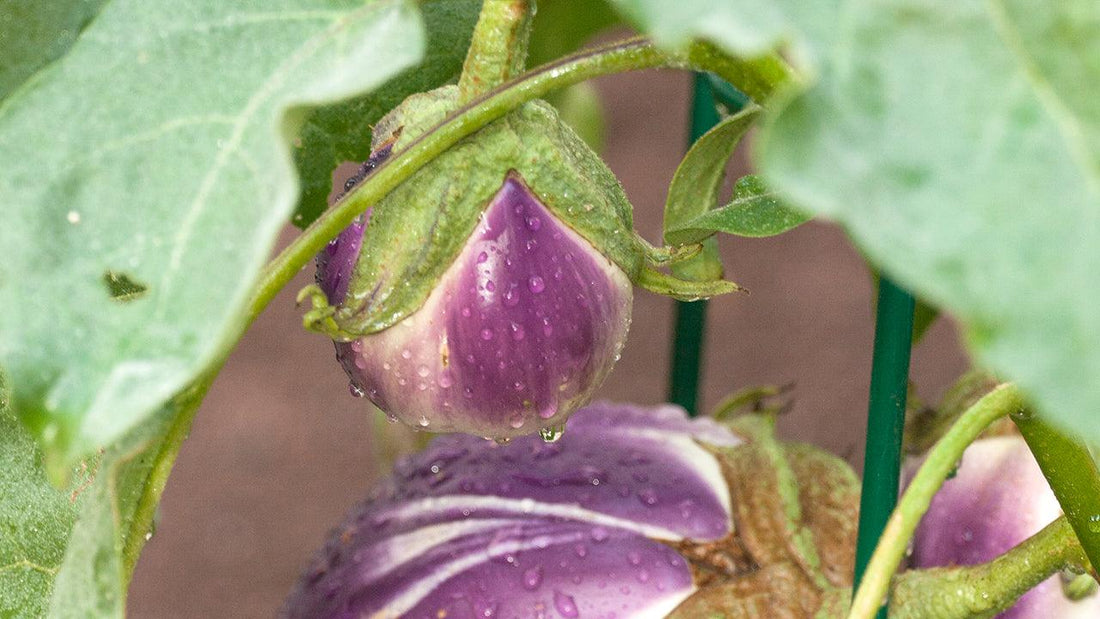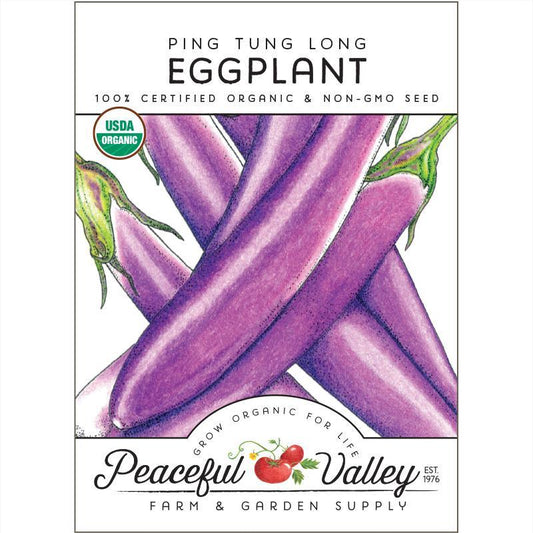Eggplant has been cultivated for more than 1,500 years throughout India and China. Eggplant, a member of the Solanaceae (nightshade) family, is a tender plant and therefore must be grown during the hot summer months in the U.S. There are several types to chose from, but all need warm temperatures to thrive and fruit. Cook up some baba ganoush, moussaka, and eggplant parmesan!
If you're wondering when, exactly, is a good time to plant your eggplant seeds, enter your last frost date (for spring planting) and first frost date (for fall planting) into our Seed Planting Calculator. It will calculate the best dates to direct seed or start seeds indoors.
You can also calculate when to plant your seeds by using the sowing information on the back of the seed pack and counting backwards from your last frost date on your calendar.

Eggplant Types
Asian: Long and narrow shape; delicate flavor; low seed count; range of purple shades, green or white. Examples are Ping Tung Long and Mixed Fingers.
Globe: Pear shaped (often called American), dark purple. Larger and thicker than the Italian varieties. Example is Black Beauty.
Graffiti: Similar to Italian varieties; mottled white and purple skin; sweeter. Example is Rosa Bianca and Listada de Gandia.
Indian: Very small; dark purple; tender.
Italian: Similar to but smaller than the Globe; dark purple; tender; sweeter than most. Example is Diamond.
Growing Basics
Soil: Eggplant prefers a soil pH around 6.5 and temperatures of 70–85°F (80°F for germination), but tolerates 65–90°F (70°F nights is needed for bloom set). Try growing eggplant in some of our Peaceful Valley Organics Potting Soil; it is an excellent, organic all-around mix.
Seed longevity: If properly stored, eggplant seeds should be viable for about 4 years.
Spacing: 18 to 24 inches apart with rows 2 to 3 feet apart.
Companion planting:
- Incompatibility — None, however planting near others in the same family (tomatoes, potatoes, peppers) may accelerate diseases and pests.
- Companions — beans, peas, tomatoes, spinach, peppers, marjoram
Water requirements: Eggplant is fairly drought tolerant, but will be bitter and/or small if not consistently damp, (but avoid over watering for soggy soil).
Fertilization: Do not over fertilize with nitrogen, you will get bushy plants but they will bear a smaller set of fruit. Better to use a fertilizer with a higher, phosphate and potassium percentages. Amend soil prior to transplanting into garden; supplement per product label. Eggplant also needs a lot of calcium, so add lime to the soil before you plant. Weekly watering with kelp will assist with plant strength. Amending after flowering will help extend harvest season.
Planting & Growing
Seed Sowing: Due to tender nature, start seeds indoors 8–12 weeks before last frost date. Sow per seed pack depth in damp soilless mix (Quickroot) to prevent damping off and facilitate easy emergence. To prevent root disruption at transplanting, plant in individual pots.
Moisten with sprayer or mister. Cover with dome (optional) to prevent drying out (take off during the day if condensation is building up). Maintain soil as just moist (overwatering will displace or degrade seed). Place in an warm area with very good light or under grow lights. If using heat mats set at 80°F for germination.
After first set of true leaves form, begin to supplement with half dilution hydrolyzed fish and kelp every 14 days.
Before transplanting to garden, place plants in a sheltered area outdoors during day and bring in at night to harden off.
Transplanting: Wait until soil is 75–80°F in the morning hours. Select a sheltered area in full sun. Work soil well and amend per soil report recommendations or add ½ cup balanced vegetable fertilizer in perimeter. Space 18–24” apart in well drained soil with sufficient depth for roots. Do not plant deeper than the original soil level.
Water lightly to settle soil. Stake or trellis once plants get heavy with fruit. Apply mulch (black plastic) to increase yields. Cover plants with row covers if nights will fall below 50°F. Pinch out early flowers to allow adequate root formation.
To help improve air circulation and cut down on some of the bushiness you can prune out suckers that grow below the first fruit set.
Harvesting
Cut rather than pull fruit off plants. Skin should be shiny and not wrinkled (sign of dehydration). Press thumb into skin and it is ripe if depression recovers. If over-ripe skin will remain indented; if under-ripe it will be hard to depress. Some eggplant varieties turn yellow or orange when they are over ripe. Remove all over ripe fruit to promote more flowers.
Do not wash until ready to use. Eggplant does not store well so it should be eaten soon after harvest. You can store it for a few days in refrigerator or a few days on the counter if humid and kept above 50°F.
For immediate eating, eggplants can be baked, grilled, roasted, stuffed, or mashed. Preserved your eggplant harvest by drying, pickling, or freezing.
Common Pests & Diseases

Aphids: Usually found on the underside of leaves or on flower head. Control by strong spray of water (our Bug Blaster Spray Nozzle works great), beneficial insects, or organic insecticide labeled for aphids.
Bacterial Wilt: Remove and discard all fruits and bush. Cover young plants with tunnels to prevent exposure. Use crop rotation to non-susceptible plants.
Colorado Potato Beetles: To control use sticky traps, an organic insecticide labeled to control Colorado potato beetles or a row cover such as Agribon AG15.
Flea Beetles: Attack young plants and leaves small holes in foliage. To control use sticky traps, row covers such as Agribon AG15 or an organic insecticide labeled to control flea beetles.
Fusarium: Common soil borne disease. Solarize soil and add organic matter. Use crop rotation to non-susceptible plants.
Verticullium: Soil borne. Solarize soil or use crop rotation to non-susceptible plants. Add organic matter.
Whiteflies: Usually found on the underside of leaves or on flower head. Control by strong spray of water, beneficial insects, or organic insecticide labeled for whiteflies.
Pest Control–IPM
Integrated Pest Management (IPM) is an effective and environmentally sensitive approach to pest management that starts with the least invasive or impactful control methods and considers the use of chemical controls as the last step. For more information watch our Integrated Pest Management video.
Important to practice good cultural controls for pest management of eggplant. Cultural controls such as removing plants after harvest (to avoid leaving food for insects to continue to multiply on), use clean transplants, practice crop rotation (i.e. do not plant crops in same family, Solanaceae, in the same area for 3 years), use row covers such as Agribon AG15 (cover before insects have arrived).
Common Questions
Are eggplants perennials or annuals? Can be a short term perennial if grown in warm regions, generally grown as an annual.
How do I increase the yield from my eggplants? Allow only about 5 fruits at a time and pick young as new flowers will form or plant additional plants. Keep soil warmer to extend season by wrapping base of support with fabric.
Why are my eggplants malformed? Usually a result of inadequate pollination (attract pollinators) or inconsistent moisture.
Definitions
Heirloom: Heirloom seeds come from open-pollinated plants that pass on similar characteristics and traits from the parent plant to the next generation plant. Heirloom vegetables are old-time varieties generally which have been in production since before WWII, and have been saved and handed down through multiple generations.
Hybrid: a cross between two or more unrelated plant varieties. The two different varieties are cross bred, resulting in a seed that carries one or more favorable traits (increased yield, uniformity, color, disease resistance.) Hybrid seeds are not GMO, as they are manually cross-bred, not genetically modified in a lab. Hybrid seed is often sterile or does not reproduce true to the parent plant. Therefore, never save the seed from hybrids.
Open Pollinated: generally refers to seeds that will “breed true”. When the plants of an open-pollinated variety self-pollinate, or are pollinated by another representative of the same variety, the resulting seeds will produce plants roughly identical to their parents. Genetic traits may differ only slightly due to variations created by local conditions.
GMO: Genetically Modified Organisms were genetically modified in a laboratory where DNA genes are extracted and mixed with other unrelated plants to improve characteristics. Saved seed will not always be viable and may be trademarked to prevent unauthorized use.



